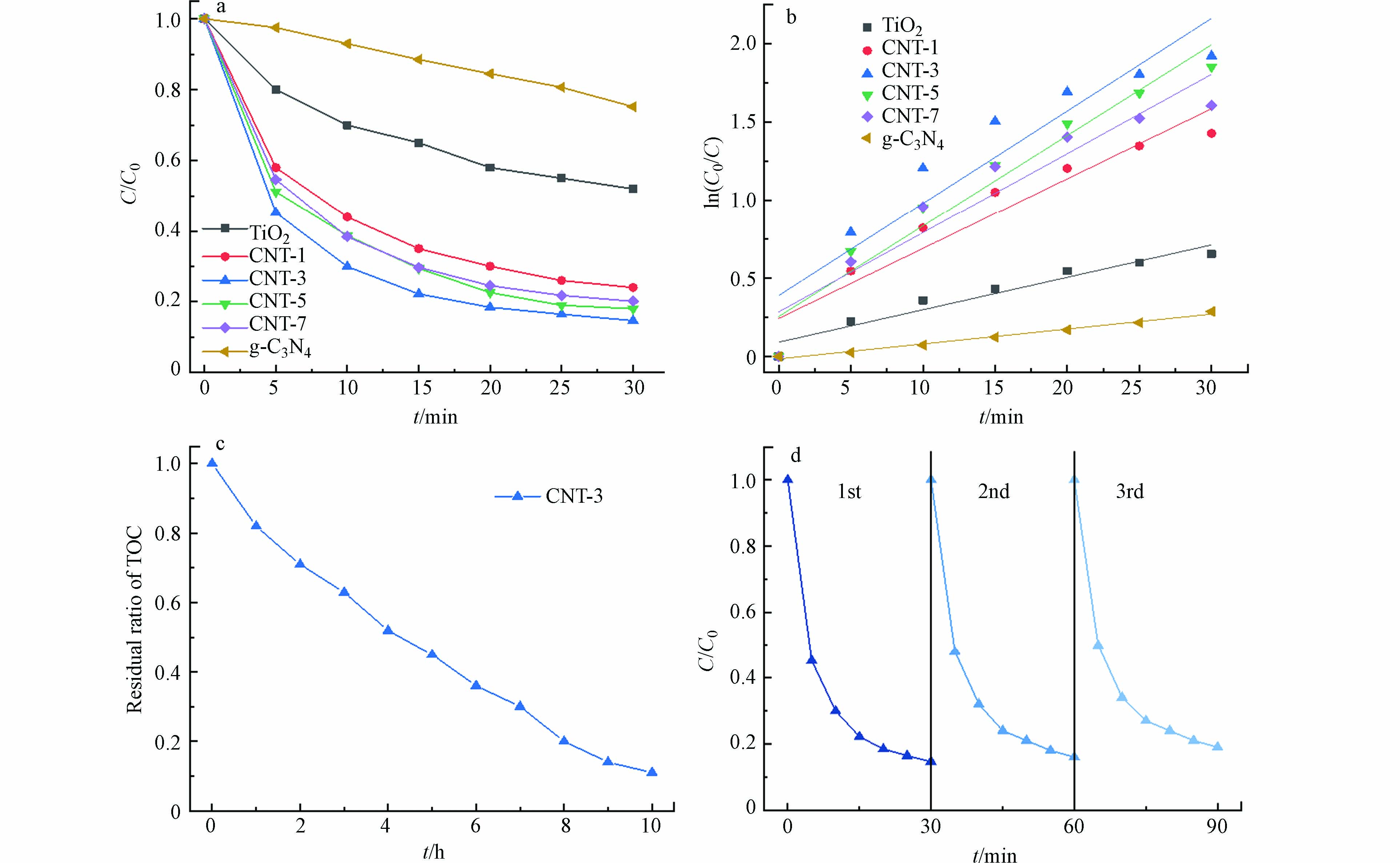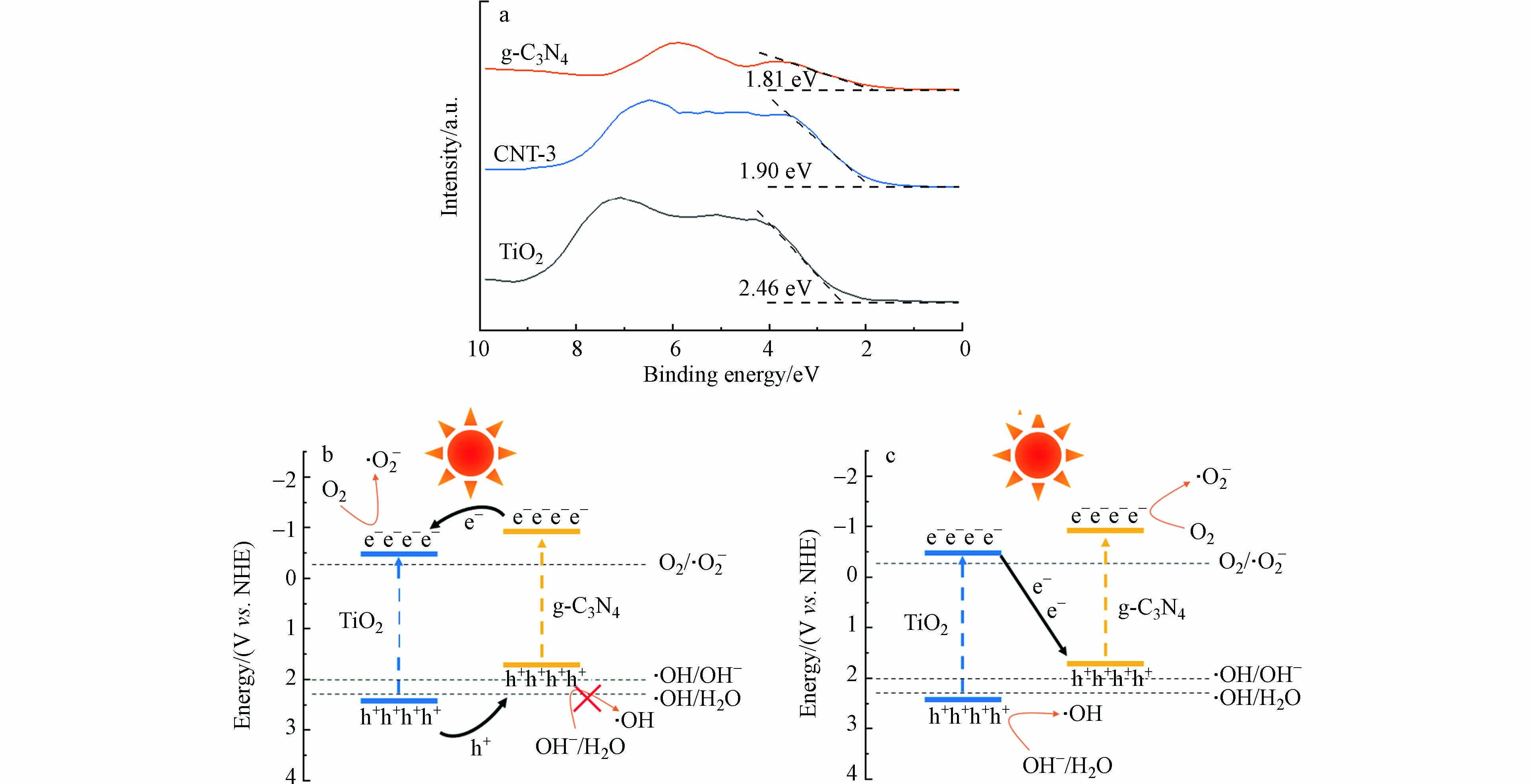-
四环素(TC)是使用最广泛的抗生素,常被用作疾病治疗剂和牲畜生长促进剂,在全球多地区地表水和地下水中均可检出,对生态系统和人类健康造成不利影响[1-2]. 高级氧化技术(advanced oxidation processes,AOP)是当前公认的最佳水处理技术. 其中,光催化氧化技术(photo catalytic oxidation,PCO)由于可以在温和条件下直接利用太阳能去除污染物而受到广泛关注,具有氧化活性强、成本低、操作流程简单、无二次污染等优点,符合未来绿色清洁技术的发展理念[3-5]. 光催化剂作为该技术的关键,其本身的物理化学性质会关系到催化反应的进程,影响对污染物的去除效果. 因此,制备高效的光催化剂是目前研究的热点[6-8].
在众多光催化材料中,二氧化钛(TiO2)因光催化活性高、化学稳定性好、廉价易得、环境友好等优势而受到青睐,但电子空穴复合速率高以及带隙宽导致其难以利用可见光的弊端始终阻碍其发展[9]. 为此,科研工作者提出掺杂[10-11]、半导体复合[12]、晶面工程[13]、缺陷工程[14]等策略以抑制电子空穴复合、拓宽光响应范围,进而提高TiO2光催化应用范围,虽然晶面工程、缺陷工程等改性方法有效的提升了TiO2的光催化活性,但是复杂的工艺流程、大量的化学试剂、高温高压的制备环境等是注重绿色合成的今天应该改善的.
与窄带隙半导体构建复合材料因可在调控能带结构的同时兼具两种材料的优势,被认为是应用前景广阔的改性方法[15]. 石墨相氮化碳(g-C3N4)是一种典型的非金属、窄带隙半导体,其拥有稳定的化学结构和独特的光学性质[16]. 而其光响应范围广的特性刚好能满足提升TiO2催化活性的需求. 近年来,围绕g-C3N4与TiO2复合型光催化剂的报道频出,Pelin等通过阶梯水热法和高温热处理,构筑了g-C3N4/TiO2异质结光催化剂,实验证明其能够在太阳光下高效降解水中亚甲基蓝[17];Ma等制备的g-C3N4/TiO2纳米管实现了在可见光下对邻氯硝基苯的高效降解[18],但大多研究具有工艺流程复杂、掺杂组分比例难以精确控制、需要高温煅烧等缺点. 前期通过机械混合制备了一系列的g-C3N4/TiO2复合材料,其能够在可见光驱动下高效降解双酚A[19]. 但当前研究少有关于g-C3N4/TiO2复合材料对TC降解性能的评估,特别是在复杂水环境条件下光降解性能的考察.
为贯彻绿色合成制备高效光催化剂,本研究采用简便的原位水热处理,通过将质量不同的g-C3N4和TiO2纳米颗粒复合,成功制备了一系列g-C3N4/TiO2复合材料. 表征并分析了复合材料的表面结构、光学特性和光电化学性能,证实Z型异质结的构建. 测试了最优催化剂CNT-3复合材料在可见光条件下在不同的投加量、较宽的pH范围以及不同的污染物浓度下降解TC,并提出了降解机制. 本研究实现了复合材料在较宽泛条件下对TC的高效降解,为复合型光催化剂的发展提供新思路.
-
三聚氰胺(AR,99%)、钛酸四丁酯(AR,99%)、四环素(BR,≥98%)、乙醇(AR,95%)、异丙醇(AR,99.5%)、超氧化物歧化酶(SOD,AR,99%)、乙二胺四乙酸二钠(AR,98%)均购置于凯玛特(天津)化工科技有限公司.
-
将3 g三聚氰胺放置在100 mL的陶瓷坩埚中,放入高温炉中在550 ℃煅烧2 h,升温速率为5 ℃·min−1,待高温炉自然冷却至室温后将得到的淡黄色块体催化剂取出,用研钵将其磨成粉末状后收集,即为石墨相氮化碳(g-C3N4).
-
将15 mL无水乙醇和10 mL去离子水混合于烧杯中,然后量取4.27 mL钛酸四丁酯缓慢滴入其中,磁力搅拌0.5 h,将搅拌均匀的悬浮液转移到50 mL的水热反应釜中,放入鼓风烘箱中在180 ℃下反应6 h;将水热反应完成后的混合液置于室温下,等待其自然冷却. 接着将上层液体倒掉,并收集底部的白色粉末. 随后,采用去离子水和无水乙醇反复清洗白色粉末. 将洗净后的白色粉末干燥,再使用研钵进行研磨,收集即得到TiO2纳米材料.
-
称取不同质量上述制备好的g-C3N4粉末(10、30、50、70 mg)分别置于10 mL去离子水中,超声分散1 h,命名为溶液A;分别称取4.27 mL钛酸四丁酯置于15 mL无水乙醇中,磁力搅拌0.5 h,命名为溶液B;将分散好的溶液A分别转入溶液B中,然后在室温下剧烈磁力搅拌1 h,直至悬浮液混合均匀.
将悬浮液转移到50 mL的水热反应釜中,放入鼓风烘箱中在180 ℃下反应6 h;将水热反应完成后的混合液置于室温下,等待其自然冷却. 接着将上层液体倒掉,并收集底部的淡黄色粉末. 随后,采用去离子水和无水乙醇反复清洗淡黄色粉末. 将洗净后的淡黄色粉末干燥,再使用研钵进行研磨,收集即得到g-C3N4/TiO2复合材料,分别命名为: CNT-1(g-C3N4投料10 mg)、CNT-3(g-C3N4投料30 mg)、CNT-5(g-C3N4投料50 mg)、CNT-7(g-C3N4投料70 mg).
-
通过X射线衍射(XRD)图案(Shimadzu XRD-6100)和Cu Ka辐射(λ = 1.54056 Å)证实样品的化学和结构信息. 表面化学成分通过FT-IR光谱(Frontier Mid-IR FTIR)和X射线光电子能谱(XPS,phi-5700 ESCA)确定. 利用扫描电子显微镜(SEM,Nova Nano SEM 460,FEI)确定形态特征. 孔隙结构和比表面积用Quantachrome Nova 4000a分析仪进行了表征. 样品的带状结构用紫外-可见分光光度计(Lambda 750 UV/VIS/NIR)进行了探索. 瞬时光电流曲线是在三电极系统电化学工作站进行的,包括铂片(对电极)、催化剂(工作电极)和饱和甘汞电极(SCE). 使用300 W的Xe灯作为光源,记录电流时间(I-t)曲线. 电化学阻抗光谱(EIS)由阻抗测量工作站获得(频率范围:0.1106 Hz;正弦交流扰动:5 mV).
-
评估光催化剂的光催化性能是通过在可见光下光催化降解四环素来实现的. 300 W氙灯作为光源(加装400 nm滤光片),光催化反应器置于氙灯之下,反应液面距光源10 cm,光照强度7 mW·cm−2. 实验装置处于封闭的实验环境中,排除外源光源干扰,以确保实验数据结果的可靠性和真实性.
光催化实验中,在装有100 mL四环素溶液(20 mg·L−1)的石英反应器中加入0.05 g催化剂. 光照前,将悬浮液在黑暗中磁搅拌30 min,使催化剂与四环素达到吸附-解吸平衡,然后暴露于光源下,磁搅拌启动反应. 每隔一定时间,用注射器提取约3 mL的悬浮液,通过0.22 μm的聚四氟乙烯注射器过滤器,完全去除催化剂粉末. 用紫外-可见光谱(四环素在357 nm处的特征吸收峰)分析四环素的剩余浓度,得到光催化四环素的降解曲线.
-
通过XRD对光催化剂的化学和结构组成进行表征,如图1所示,制备的CNT复合材料可以观察到与锐钛矿型TiO2(PDF#21-1272)相同的衍射峰形状,对应良好,没有杂峰,这表示TiO2自身结构没有在与g-C3N4复合过程中发生变化[20]. 另外,由于g-C3N4所占比例低,所以在CNT复合材料的XRD图谱中并未观察到属于g-C3N4的特征峰.
-
图2是TiO2、g-C3N4和CNT复合材料(以CNT-3为例)的SEM图. 由图2可见,TiO2为规则的球形纳米颗粒,但有明显的团聚现象;g-C3N4呈片状结构,是较小片状结构的聚集体. CNT复合材料显示为TiO2纳米颗粒分散负载于g-C3N4表面,TiO2纳米颗粒的团聚现象也得到了缓解,利于光的吸收,也可增大污染物分子与催化剂的接触面积,有益于降解体系的进行,CNT复合材料保持了与g-C3N4相同的结构,表明成功制备了复合材料.
-
为了进一步观察复合材料的表面特征,进行了XPS测试. 如图3(a)所示,CNT复合材料表面的元素分布为C、N、O、Ti,其中N元素仅来源于g-C3N4,且N的特征峰强度随着g-C3N4掺杂比例的升高而增大,Ti元素来源于TiO2,进一步证明复合材料由g-C3N4与TiO2复合而来. 如图3(b)所示,Ti 2p高分辨图谱在458.4 eV和464.2 eV处显示两个峰,分别对应于Ti4+中Ti 2p3/2和Ti 2p1/2轨道的分裂峰. 在图3(c)中,O 1s在529.7 eV和531.5 eV处的两个峰被拟合,分别对应于Ti—O和O—H键,531.5 eV处的峰值与CNT复合材料表面存在羟基或水分子有关. 图3(d)显示了N 1s在398.6、400.0、401.0 eV处的3个峰,分别对应于碳原子键合的sp2杂化芳族氮的特征峰(C—N=C)、叔氮的特征峰[N—(C)3]和氨基的特征峰(H—N—H). 图3(e)显示出C 1s在284.8 eV和287.4 eV处的两个峰,前者归因于C—C键的协同效应,包括来自XPS仪器本身的污染碳和存在于g-C3N4的sp2杂化碳原子,287.4 eV处的另一个峰对应于N—C=N键的协同效应.
-
图4为复合材料的FTIR谱图,3500—3000 cm−1内特征峰对应于O—H和N—H振动峰,O—H源于TiO2表面吸附的水解离生成的羟基,N—H归属于g-C3N4分子中的氨基. 位于800—400 cm−1内的宽峰,在除g-C3N4的样品中都能观察到,这归属于Ti—O键的伸缩振动峰. 1516 、1468、1318 cm−1处为C—N和C=N的主要骨架振动峰,在CNT-1至CNT-7中,随着g-C3N4掺杂比例的增高,C—N的特征峰逐渐增高,表示g-C3N4在复合材料中的定量控制. 另外,未发现2224 cm−1附近的C≡N伸缩振动吸收峰,再次验证CNT复合材料中的前驱体保持稳定,原位生成了g-C3N4/TiO2异质结构.
-
制备材料的氮气吸附-脱附等温线和孔径分布图如图5所示,3种材料的吸附-脱附等温线均可归属于Ⅳ型滞后回环,表明TiO2、CNT-3、g-C3N4均为介孔材料[21]. 表1为所有材料的BET比表面积和孔容量,可以看出,复合材料相比纯TiO2比表面积有所增加、孔容有所减小,这再次验证g-C3N4的引入能降低复合材料结晶度,减少团聚,提高复合材料比表面积,这有利于复合材料对污染物分子的吸附. 但当g-C3N4掺杂量过大时,比表面积相较于低掺杂量的复合材料略有下降,这是因为当g-C3N4超过一定量后,容易破坏TiO2原本的形貌和孔隙结构,降低复合材料比表面积.
-
通过TC的光催化降解实验来评估制备催化剂的光催化性能,如图6(a)所示,与TiO2和g-C3N4相比,全部CNT复合材料呈现出更高的降解效率. 在一系列的复合材料中,CNT-3对TC的光催化降解效率最高,反应进行30 min后,对TC的去除率高达85.4%,此时纯TiO2和g-C3N4对TC的去除率仅为48.0%和24.8%,值得注意的是,10 min时CNT-3对TC的去除率已达到70.1%. 图6(b)直观地表示出整个反应体系的线性关系,可以清楚的发现,CNT-3具有更高的光催化速率. 同时,为了深入探究CNT-3的光催化降解能力,进行了TOC测试来体现CNT-3对TC的矿化能力,结果如图6(c)所示,在可见光照射10 h后,CNT-3对TC的矿化率达到了89.0%,进一步证实了CNT-3复合材料在可见光下优异的光催化活性.
在相同的降解实验条件下测试CNT-3的可重复利用性,如图6(d)所示,在CNT-3降解TC的循环降解实验中,第一次降解效果最好,之后每次降解效率略有降低,经过3次循环后,降解率仍然保持较高水平,达到81.0%,说明复合材料的理化性质稳定,在反应中能够保持高的光催化降解效率.
-
以最优的CNT-3复合材料为催化剂,测试不同条件对TC降解实验的影响.
催化剂投加量对降解TC的影响,如图7(a)所示. 催化剂投加量递增,CNT-3对TC的降解率先增加后趋于稳定,最高投加量时降解率达到86.5%. 投加量从25 mg到50 mg为TC的降解提供了更多的反应活性位点,促进了反应进程的发生,使得降解率显著提高;然而当催化剂投加量继续增加到75 mg和100 mg时,过量的催化剂掩盖了部分光源,同时在反应中产生过多的自由基自身消耗,阻碍了反应进程,导致降解速率不再增加.
实际废水的pH值范围往往很大,溶液pH与催化剂的表面电性以及污染物的存在形态密切相关,会对反应进程造成影响,因此pH对于催化剂的实际环境应用有较大影响. 如图7(b)所示,pH=5、7、9的条件下,30 min内CNT-3对TC降解率差别不大,均有较高的光催化降解活性,但在强酸强碱的条件下,CNT-3对TC降解率略有下降,值得注意的是,pH=11时CNT-3对TC降解率在5 min便达到了48.4%,30 min时却仅为65.8%,Farzaneh等[22]研究表明强碱性条件下TC会变的不稳定且光吸收强度增加,使得TC易于在碱性条件下光解,但是同时CNT-3复合材料表面和TC分子都带负电荷,催化剂和TC之间存在排斥力,这些分子的排斥力和催化剂表面的负电荷会阻止阴离子到达催化剂表面附近,而这里恰恰是催化剂与污染物分子接触反应的地方,因此,造成了CNT-3在强碱性条件下前期降解速率快而整体降解率低. 相似的,TC主要以TCH+3、TCH2、TCH-、TC-2的形式在水溶液中存在,其解离常数(pKa)为3.32. 在强酸性条件下,催化剂由于表面质子化而带正电,会在催化剂与污染物之间产生静电斥力,进而造成降解效率下降[23]. TC在弱酸、弱碱和中性条件下更容易被催化剂产生的自由基分解,这也与我们的实验结果相符. 上述结果表明,CNT-3复合材料能够在较广pH范围内去除TC.
TC初始浓度对光催化降解效率的影响,如图7(c)所示,污染物的初始浓度越低光催化降解反应越快,相应地,初始浓度越高光催化降解反应越慢. 原因有二,一是TC降解产生的中间产物吸附在催化剂表面,阻碍了反应进行;二是催化剂表面反应活性位点有限,污染物浓度过高使其难以承受. 结合实际污水中TC浓度以及CNT-3材料降解TC的光催化活性,20 mg·L−1的中等TC浓度下CNT-3有较高的光催化活性表现.
-
为探讨CNT-3复合材料的光催化反应机理,在光催化降解TC反应体系中加入3种自由基捕获剂进行淬灭实验,探究不同光生自由基在降解过程中的贡献. 如图8所示,加入异丙醇(IPA,·OH捕获剂)、SOD(·O2-捕获剂)、乙二胺四乙酸二钠(EDTA-2Na,h+捕获剂)后降解率有不同程度的下降. 从图8(a)中可以看出随着不同浓度IPA的加入,TC的降解效果受到了很大的抑制作用,但随着IPA浓度的增大,对去除TC的抑制作用变化不大,这表明在TC的光催化降解体系中·OH有较大的贡献,是主要的活性物质. 图8(b)中随着SOD的加入,TC的去除得到了轻微的抑制,SOD浓度增大后抑制作用也不明显,表明·O2-对TC的去除仅有轻微的作用. 图8(c)中不同浓度EDTA-2Na的加入导致TC的降解受到了明显的抑制,降解速率也变慢,这说明h+在TC降解体系中扮演重要角色. 综上可知,在CNT-3复合材料对TC的光催化降解体系中起最重要作用的是·OH和h+,·O2-的贡献相对较少.
-
为了探究CNT-3复合材料高光催化活性的原因,首先通过UV-Vis分析催化剂光响应能力,由图9(a)可见,相比于TiO2,g-C3N4的引入为CNT复合材料带来了更高的光吸收能力,不仅增强了在紫外光区的吸收能力,而且拓宽了可见光吸收,说明原位水热法向TiO2体系中引入g-C3N4有效增强了其对可见光的吸收. 光催化剂的禁带宽度可以通过朗伯比尔定律计算[24],如图9(b)所示,随着g-C3N4掺杂量的增加,CNT复合材料的禁带宽度逐渐减小,这代表其更容易被光激发,有着更强的光响应能力. 但这并不能解释CNT-3最优光催化活性的原因,故将进一步研究样品电荷转移和分离特性差异.
-
催化剂表面电荷转移与分离能力直接决定其光催化活性. 采用瞬态光电流响应(I-T)与电化学阻抗谱(EIS)来阐述TiO2和CNT复合材料的电子传输特性. 如图10(a)所示,CNT-3的光电流响应强度最大,且所有CNT复合材料的光电流响应强度均大于纯TiO2,说明光生载流子的传递效率因为g-C3N4的引入而得到有效的提升. 图10(b)是各材料的EIS-Nyquist图,可以清晰地看到每个样品的EIS数据都是圆弧,其中圆弧的大小反映了载流子的转移电阻大小(Rct),这是影响催化剂活性重要的因素. 很显然,CNT-3的半径最小,意味着载流子转移电阻最小,而所有的CNT复合材料的转移电阻均小于纯TiO2. 值得注意的是,I-T与EIS结果与前面TC降解结果一致. 综上所述,CNT-3复合材料拥有最佳的电荷转移与分离能力是使其具有最优光催化降解活性的主要原因.
-
根据UV-Vis DRS光谱和(αhν)2-hv关系曲线图,分析得到TiO2和g-C3N4的禁带宽度分别为2.94 eV和2.75 eV. 如图11(a)所示,根据XPS价带谱分析得到TiO2和g-C3N4的价带分别为2.46 eV和1.81 eV. 为明确TiO2和g-C3N4的能带结构,由禁带宽度和价带位置进一步计算得到TiO2和g-C3N4的导带为−0.48 eV和−0.94 eV. 根据淬灭实验和能带结构分析,推测TiO2和g-C3N4之间的电荷转移机制及CNT复合材料在光催化体系内的催化机理. g-C3N4的价带和导带位置均高于TiO2,因此,推测TiO2和g-C3N4之间存在两种相互作用机制,II型异质结(图11b)或Z型异质结(图11c)[25-26].
第一种情况,假设TiO2和g-C3N4形成了II型异质结构,光生空穴倾向于从TiO2的价带迁移到g-C3N4的价带,g-C3N4的价带边缘(1.81 eV)明显低于OH−/·OH(1.99 eV)或H2O/·OH(2.34 eV),使得聚集在g-C3N4价带中的光生空穴无法将吸附在表面的OH−或H2O分子氧化成·OH. 但是淬灭实验证明CNT-3在光催化降解TC的过程中可以产生·OH,并且·OH在反应中起主要作用,这与上述假设的II型异质结结构相矛盾,因此,该假设不成立. 第二种情况,假设TiO2和g-C3N4形成了Z型异质结构,TiO2的光生电子从TiO2导带向g-C3N4的价带迁移与g-C3N4在价带位置产生的空穴复合,这一过程抑制了TiO2和g-C3N4光生载流子的重组. 光生电子和空穴分别在g-C3N4的导带和TiO2的价带积聚,由于g-C3N4的导带边缘(−0.94 eV)负于TiO2的导带边缘(−0.48 eV)且远负于O2/·O2−(−0.046 eV),可以实现光生电子还原O2产生·O2−. TiO2的价带边缘(2.46 eV)高于OH−/·OH(1.99 eV)或H2O/·OH(2.34 eV),这可以实现光生空穴氧化OH−或H2O产生·OH,这与淬灭实验结论相一致,因此,该假设成立,本研究中的CNT复合材料之间存在Z型异质结构. 由于g-C3N4的导带边缘比TiO2更负,而TiO2的价带边缘比g-C3N4更正,这让CNT复合材料比纯TiO2和g-C3N4更容易产生·O2−和·OH自由基. 光生电子在TiO2导带到g-C3N4价带的转移,可以进一步促进光生电子与空穴的分离,并且可以抑制光生载流子的复合. 最终CNT复合材料表现出更高的光催化降解TC的性能.
-
采用简便高效的原位水热法将g-C3N4与TiO2复合,制备了系列g-C3N4掺杂量不同的g-C3N4/TiO2复合材料, 在可见光下降解TC,通过不同实验条件对比,探讨了多种条件下的降解性能以及降解机理,发现g-C3N4/TiO2复合材料的光催化活性均优于纯g-C3N4与TiO2,尤其g-C3N4掺杂量为3%的CNT-3复合材料,具有最高的光催化降解活性,其能够在宽泛条件下高效降解TC,并且在反应环境中保持良好的结构稳定性和光催化循环稳定性,有良好的实际应用前景. 这得益于原位水热的合成方法使得g-C3N4能够精准定量的引入TiO2体系,不仅拓宽了TiO2的光吸收范围,而且两者间形成的Z型异质结有效促进光生载流子的分离和转移,这极大的提高了g-C3N4/TiO2复合材料的光催化活性. 本项工作进一步拓宽了改性TiO2基材料在可见光下的应用,阐明了反应机理,也为精准定量构建复合光催化材料提供了新思路.
宽泛条件下光催化降解四环素的C3N4/TiO2复合材料的性能研究
Study on the properties of C3N4/TiO2 composites capable of photocatalytic tetracycline degradation under a wide range of conditions
-
摘要: 本研究采用简便的原位水热法成功制备了g-C3N4/TiO2复合材料. 采用X射线粉末衍射(XRD)、扫描电子显微镜(SEM)、X射线光电子能谱(XPS)、傅立叶红外光谱(FTIR)、比表面积分析仪(BET)、紫外可见漫反射光谱仪(UV-Vis)、电化学工作站等对其物像、结构、形貌、光学特性和光电化学性能进行表征;以四环素(TC)为目标污染物在可见光下进行光催化降解实验,研究催化剂投加量、溶液pH、污染物浓度等不同条件对g-C3N4/TiO2复合材料降解TC效果的影响,通过自由基捕获实验探讨其光催化降解TC的机理. 结果表明,g-C3N4/TiO2复合材料对TC的光催化降解效果均优于纯g-C3N4和TiO2,掺杂量为3%的CNT-3光催化活性最好,且有着优秀的矿化能力;复合材料能够在较少的投加量、较宽的pH范围以及较高的污染物浓度下高效降解TC,并且能够在反应环境中保持稳定,•OH自由基和空穴在反应体系中起主要作用. g-C3N4和TiO2之间存在的Z型异质结,有效减少光生载流子复合,g-C3N4的引入不仅拓宽了TiO2的光响应范围,而且促进了电荷转移和分离,提高了复合材料的光催化活性.Abstract: In this work, g-C3N4/TiO2 composites were successfully prepared by simple in situ hydrothermal method. X-ray powder diffraction (XRD), scanning electron microscopy (SEM), X-ray photoelectron spectroscopy (XPS), Fourier infrared spectroscopy (FTIR), specific surface area analyzer (BET), UV-visible diffuse reflection spectrometer (UV-Vis), electrochemical workstation were used to investigate the object image, structure, morphology, optical properties and photoelectric chemical properties were characterized; Tetracycline (TC) was used as the target pollutant to conduct photocatalytic degradation experiments under visible light. The influences of different conditions such as catalyst dosage, solution pH and pollutant concentration on the TC degradation effect of g-C3N4/TiO2 composites were studied. The mechanism of photocatalytic TC degradation was discussed through free radical capture experiments. The results show that the photocatalytic degradation effect of g-C3N4/TiO2 composites on TC is superior to that of pure g-C3N4 and TiO2. The photocatalytic activity of CNT-3 doped with 3% is the best, and it has excellent mineralization ability. The composite can effectively degrade TC with less dosage, wider pH range and higher pollutant concentration, and can maintain stability in the reaction environment. •OH radical and h+ play a major role in the reaction system. The existence of Z-type heterojunction between g-C3N4 and TiO2 effectively reduces photogenerated carrier recombination. The introduction of g-C3N4 not only broadens the photoresponse range of TiO2, but also promotes charge transfer and separation, which greatly improves the photocatalytic activity of the composites.
-
Key words:
- titanium dioxide /
- photocatalysis /
- tetracycline /
- Z-type heterojunction
-

-
图 6 (a)合成样品的可见光降解TC曲线,(b)对应的一级反应动力学曲线,(c)CNT-3复合材料对TC的矿化效果,(d)CNT-3复合材料对TC的循环使用效果
Figure 6. (a) Visible light degradation TC curve of the synthesized sample, (b) corresponding first-order reaction kinetics curve, (c) TC mineralization effect of CNT-3 composite, (d) recycling effect of CNT-3 composite on TC
表 1 合成样品的比表面积和孔容
Table 1. Specific surface area and pore volume of the synthesized sample
样品
Samples比表面积/(m2·g−1)
BET孔容/(cm3·g−1)
Pore volumeTiO2 185.41 0.29 CNT-1 196.65 0.27 CNT-3 194.81 0.27 CNT-5 190.99 0.27 CNT-7 189.26 0.27 g-C3N4 11.91 0.05 -
[1] ZHU X D, WANG Y J, SUN R J, et al. Photocatalytic degradation of tetracycline in aqueous solution by nanosized TiO2 [J]. Chemosphere, 2013, 92(8): 925-932. doi: 10.1016/j.chemosphere.2013.02.066 [2] WU S Q, HU H Y, LIN Y, et al. Visible light photocatalytic degradation of tetracycline over TiO2 [J]. Chemical Engineering Journal, 2019, 382: 122842. [3] SAEED M, MUNEER M, HAQ A U, et al. Photocatalysis: An effective tool for photodegradation of dyes-a review [J]. Environmental Science and Pollution Research International, 2022, 29(1): 293-311. doi: 10.1007/s11356-021-16389-7 [4] WANG X N, SAYED M, RUZIMURADOV O, et al. A review of step-scheme photocatalysts [J]. Applied Materials Today, 2022, 29: 101609. doi: 10.1016/j.apmt.2022.101609 [5] 陈丽华, 杜建斌, 王茀学, 等. ZIF-8复合物光催化去除水体污染物 [J]. 环境化学, 2022, 41(7): 2149-2161. doi: 10.7524/j.issn.0254-6108.2021031401 CHEN L H, DU J B, WANG F X, et al. Photocatalytic removal of water pollutants in ZIF-8 composites [J]. Environmental Chemistry, 2022, 41(7): 2149-2161(in Chinese). doi: 10.7524/j.issn.0254-6108.2021031401
[6] MA X J, TANG X J, HU Z Z, et al. Oxygen vacancies assist a facet effect to modulate the microstructure of TiO2 for efficient photocatalytic O2 activation [J]. Nanoscale, 2023, 15(2): 768-778. doi: 10.1039/D2NR05849A [7] WEI X J, AKBAR M U, RAZA A, et al. A review on bismuth oxyhalide based materials for photocatalysis [J]. Nanoscale Advances, 2021, 3(12): 3353-3372. doi: 10.1039/D1NA00223F [8] 饶志, 顾彦, 黄春迎, 等. FeVO4可见光光催化降解有毒有机污染物 [J]. 环境化学, 2013, 32(4): 564-571. doi: 10.7524/j.issn.0254-6108.2013.04.005 RAO Z, GU Y, HUANG C Y, et al. Photodegradation of toxic organic pollutants by FeVO4 under visible light irradiation [J]. Environmental Chemistry, 2013, 32(4): 564-571(in Chinese). doi: 10.7524/j.issn.0254-6108.2013.04.005
[9] SHIRAISHI F, IWANAGA M, KITAGAWA N, et al. Enhancing the photocatalytic decomposition of acetaldehyde in air by immobilized titanium dioxide [J]. Journal of Chemical Technology & Biotechnology, 2020, 95(7): 2034-2044. [10] MORETTI E, CATTARUZZA E, FLORA C, et al. Photocatalytic performance of Cu-doped titania thin films under UV light irradiation [J]. Applied Surface Science, 2021, 553: 149535. doi: 10.1016/j.apsusc.2021.149535 [11] 周乐乐, 沈知章, 唐灵铃, 等. Sn掺杂强化TiO2在湿空气中光催化降解甲苯的性能 [J]. 环境化学, 2022, 41(7): 2404-2413. doi: 10.7524/j.issn.0254-6108.2021031205 ZHOU L L, SHEN Z Z, TANG L L, et al. Sn doping enhanced the photocatalytic degradation of toluene by TiO2 in humid air [J]. Environmental Chemistry, 2022, 41(7): 2404-2413(in Chinese). doi: 10.7524/j.issn.0254-6108.2021031205
[12] SERWICKA E M. Titania-clay mineral composites for environmental catalysis and photocatalysis [J]. Catalysts, 2021, 11(9): 1087. doi: 10.3390/catal11091087 [13] BUTBUREE T, KOTCHASARN P, HIRUNSIT P, et al. New understanding of crystal control and facet selectivity of titanium dioxide ruling photocatalytic performance [J]. Journal of Materials Chemistry A, 2019, 7(14): 8156-8166. doi: 10.1039/C8TA11475G [14] ZHANG F, FENG G, HU M Y, et al. Liquid-plasma hydrogenated synthesis of gray titania with engineered surface defects and superior photocatalytic activity [J]. Nanomaterials (Basel, Switzerland), 2020, 10(2): 342. [15] CHEN H P, CHEN N, FENG C P, et al. Synthesis of a novel narrow-band-gap iron(II, III) oxide/titania/silver silicate nanocomposite as a highly efficient and stable visible light-driven photocatalyst [J]. Journal of Colloid and Interface Science, 2018, 515: 119-128. doi: 10.1016/j.jcis.2018.01.022 [16] KUMAR S, KARTHIKEYAN S, LEE A F. G-C3N4-based nanomaterials for visible light-driven photocatalysis [J]. Catalysts, 2018, 8(2): 74. doi: 10.3390/catal8020074 [17] GÜNDOĞMUŞ P, PARK J, ÖZTÜRK A. Preparation and photocatalytic activity of g-C3N4/TiO2 heterojunctions under solar light illumination [J]. Ceramics International, 2020, 46(13): 21431-21438. doi: 10.1016/j.ceramint.2020.05.241 [18] 马晓明, 信帅帅, 张春蕾, 等. g-C3N4/TiO2纳米管阵列光阳极的制备及其光电催化降解邻氯硝基苯 [J]. 环境科学学报, 2022, 42(8): 166-178. MA X M, XIN S S, ZHANG C L, et al. Preparation of g-C3N4/TiO2 nanotube arrays photoanode for photoelectrocatalytic degradation of o-chloronitrobenzene [J]. Acta Scientiae Circumstantiae, 2022, 42(8): 166-178(in Chinese).
[19] 郭盛祺, 马同宇, 杨波, 等. 机械混合法制备TiO2/g-C3N4复合材料及其光催化降解双酚A的性能 [J]. 环境化学, 2022, 41(4): 1425-1434. doi: 10.7524/j.issn.0254-6108.2020121201 GUO S Q, MA T Y, YANG B, et al. Preparation of TiO2/g-C3N4 composite material by mechanical mixing method and study on its photocatalytic degradation performance of bisphenol A [J]. Environmental Chemistry, 2022, 41(4): 1425-1434(in Chinese). doi: 10.7524/j.issn.0254-6108.2020121201
[20] GUO Q, ZHOU C Y, MA Z B, et al. Fundamentals of TiO2 photocatalysis: Concepts, mechanisms, and challenges [J]. Advanced Materials, 2019, 31(50): 1901997. doi: 10.1002/adma.201901997 [21] LIU Y L, WU S S, LIU J, et al. Synthesis of g-C3N4/TiO2 nanostructures for enhanced photocatalytic reduction of U(VI) in water [J]. RSC Advances, 2021, 11(8): 4810-4817. doi: 10.1039/D0RA10694A [22] SAADATI F, KERAMATI N, GHAZI M M. Influence of parameters on the photocatalytic degradation of tetracycline in wastewater: A review [J]. Critical Reviews in Environmental Science and Technology, 2016, 46(8): 757-782. doi: 10.1080/10643389.2016.1159093 [23] 张茜, 梁海欧, 李春萍, 等. g-C3N4/CeO2异质结材料的制备及其光催化性能的研究 [J]. 化学通报, 2022, 85(12): 1475-1482. ZHANG X, LIANG H O, LI C P, et al. Preparation and photocatalytic properties of g-C3N4/CeO2 heterojunction [J]. Chemistry, 2022, 85(12): 1475-1482(in Chinese).
[24] LINCHO J, ZALESKA-MEDYNSKA A, MARTINS R C, et al. Nanostructured photocatalysts for the abatement of contaminants by photocatalysis and photocatalytic ozonation: An overview [J]. The Science of the Total Environment, 2022, 837: 155776. doi: 10.1016/j.scitotenv.2022.155776 [25] LOW J, YU J G, JARONIEC M, et al. Heterojunction photocatalysts [J]. Advanced Materials, 2017, 29(20): 1601694. doi: 10.1002/adma.201601694 [26] Di LIBERTO G, CIPRIANO L A, TOSONI S, et al. Rational design of semiconductor heterojunctions for photocatalysis [J]. Chemistry – A European Journal, 2021, 27(53): 13306-13317. doi: 10.1002/chem.202101764 -




 下载:
下载:











